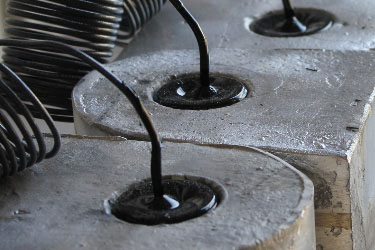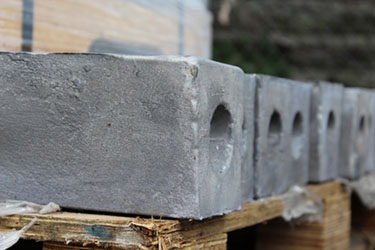A magnesium anode is used as a sacrificial anode in cathodic protection. Magnesium has the highest driving voltage of all the materials used for sacrificial anodes. Magnesium is low on the noble scale, and therefore corrodes easily compared to steel. Therefore, if it is placed within a system that uses an electrolyte, it affects the system to stop the corrosion cycle from other components requiring corrosion protection.
Sacrificial Anodes - Magnesium Anodes
To cater to the diverse requirements of cathodic protection systems in seawater, brackish water, and fresh water, we offer magnesium anodes in a range of shapes and sizes.
Our expertise in producing galvanic anodes guarantees top-quality products that can efficiently prevent corrosion when used in a well-designed and well-maintained cathodic protection system
High Potential Magnesium Anodes (Hi-Po Mags)

High Potential Magnesium anodes are ideal for providing exceptional cathodic protection in low resistivity soil conditions. We recommend using these anodes for soil resistivity between 2,000 ohm-cm and 10,000 ohm-cm. In cases where the soil resistivity exceeds 10,000 ohm-cm, we recommend using an impressed current system instead.All anodes undergo rigorous testing in accordance with ASTM G97 procedures to ensure their quality and effectiveness.
H-1 Magnesium Anodes (H1 Mags)

The H-1 alloy, commonly referred to as Standard Potential Magnesium, offers remarkable cathodic protection in low resistivity soil environments. The H-1 Magnesium anodes are expertly cast to meet the rigorous standards of ASTM AZ63, and are thoroughly tested in accordance with ASTM G97 procedures.
These anodes are highly recommended for use in areas where soil resistivity is below 2,000 ohm-cm.
Composition & Efficiency:
The composition of magnesium anodes offered by Cathtect USA complies with the specifications of U.S. Government MIL-A-21412A (Ships). This alloy comprises 6% aluminum and 3% zinc (AZ-63), which typically offers an optimal combination of economy and operating characteristics in seawater or brackish water.
The magnesium anodes from Cathtect USA exhibit a nominal current efficiency of 55% in seawater and can accommodate a current capacity of around 550 amp-hr/lb. The open circuit potential of the magnesium alloy in seawater, as measured to a copper/copper sulfate half cell, is typically -1.55 volts. In addition, the driving voltage to galvanized steel is roughly 0.70 volts, which leads to a relatively high current output per anode. Customers have the option of choosing hull and condenser anodes with a plastisol (polyvinyl chloride) coating that acts as an excellent current barrier shield.
Applications:
Magnesium anodes are effective and economical corrosion fighters that protect a variety of steel structures in salt, brackish and fresh water, including:
- Hulls of ships, barges, tugs and boats
- Ballast tanks of ore carriers and similar vessels
- Bulkheads
- Water storage tanks
- Piers and pilings
- Pipelines
- Heat exchangers
- Travelling screens
For further information, or to discuss your requirements, contact us today.
Whether you require temporary or permanent cathodic protection, suitable Magnesium anodes are available for your project. The Magnesium soil anodes we offer are capable of bringing your system to acceptable cathodic protection levels.












